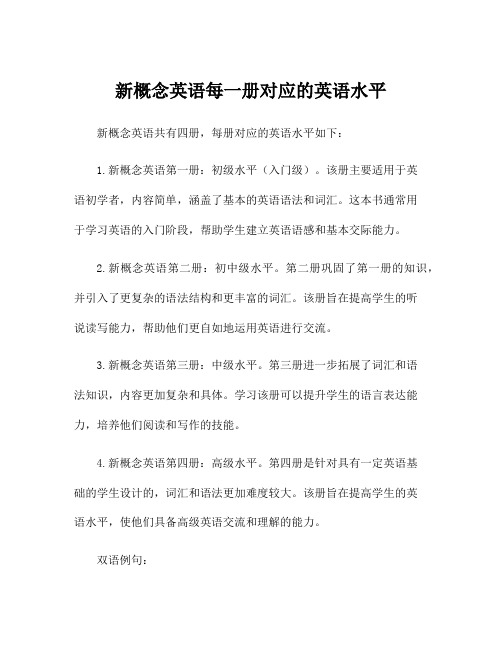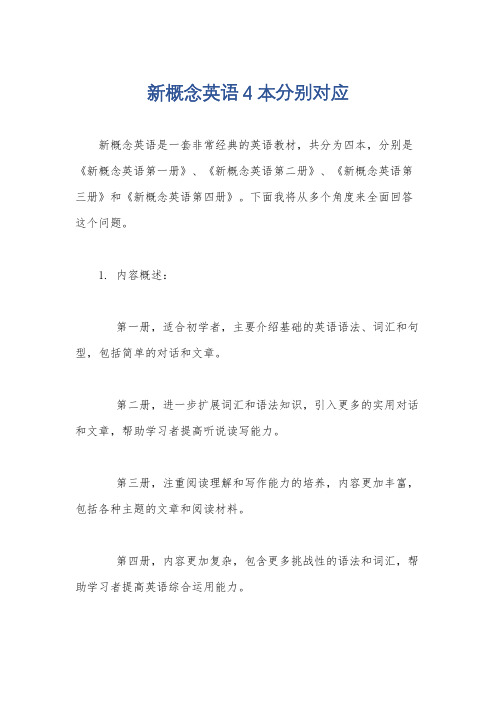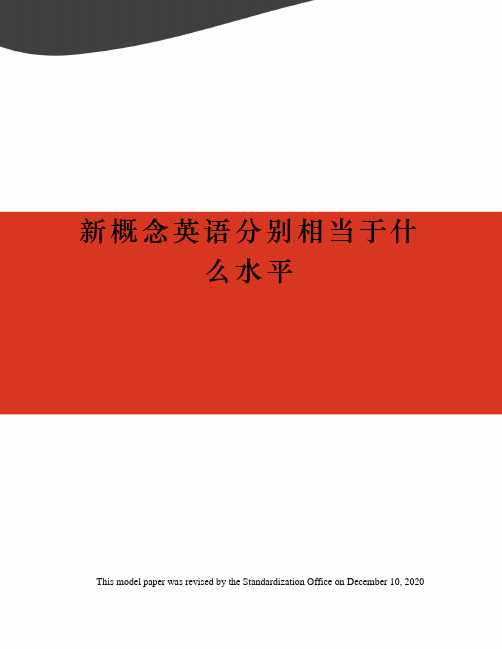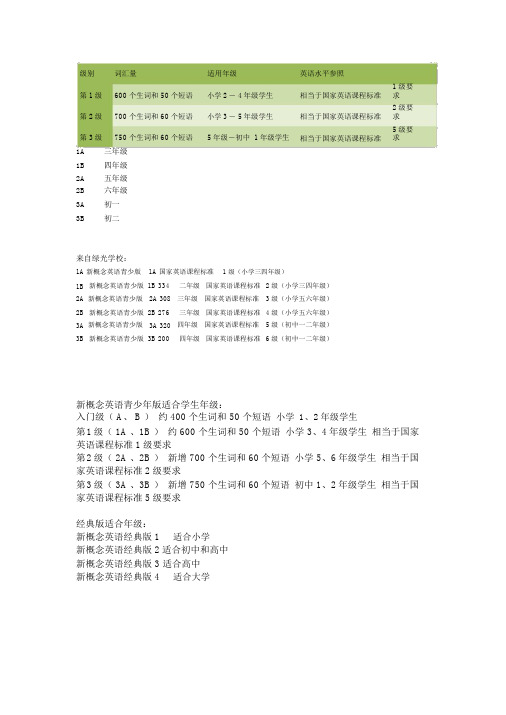新概念英语分别相当于什么水平
剑桥英语 新概念 级别对照

剑桥英语新概念级别对照(原创版)目录1.剑桥英语和新概念英语的概述2.剑桥英语和新概念英语的级别对照3.剑桥英语和新概念英语的适用人群4.剑桥英语和新概念英语的教学方法5.剑桥英语和新概念英语的优缺点6.选择剑桥英语还是新概念英语的建议正文剑桥英语和新概念英语是两种受欢迎的英语学习教材,它们各自具有一些特点和优势。
下面我们将从级别对照、适用人群、教学方法、优缺点等方面进行比较,以帮助您选择适合自己的教材。
1.剑桥英语和新概念英语的概述剑桥英语是由剑桥大学考试委员会开发的一系列英语学习教材,适用于不同年龄段和英语水平的学习者。
剑桥英语注重培养学习者的听、说、读、写四项技能,强调实际应用能力。
新概念英语是由英国语言学家路易斯·亚历山大编写的一套英语教材,分为新概念英语 1-4 册,适用于不同水平的英语学习者。
新概念英语以语法和词汇为基础,注重学习者的语言基本功。
2.剑桥英语和新概念英语的级别对照剑桥英语分为五个级别,从入门级(A1)到高级级(C2),每个级别都有对应的教材和考试。
而新概念英语分为四个级别,从初级(1)到高级(4),每个级别涵盖不同的语法和词汇内容。
3.剑桥英语和新概念英语的适用人群剑桥英语适用于不同年龄段和英语水平的学习者,特别是那些希望提高英语实际应用能力的学习者。
新概念英语则更适合那些希望打下扎实语法和词汇基础的学习者,尤其是小学生和初中生。
4.剑桥英语和新概念英语的教学方法剑桥英语的教学方法注重实践和应用,采用任务型教学法,引导学习者通过完成实际任务来学习语言。
而新概念英语的教学方法以语法和词汇为核心,采用讲解、练习和背诵等方式进行教学。
5.剑桥英语和新概念英语的优缺点剑桥英语的优点在于其注重实际应用能力,教学内容贴近生活,学习者容易产生兴趣。
缺点在于课程设置较为零散,学习者可能需要额外花费时间整理知识点。
新概念英语的优点在于其系统性强,语法和词汇知识讲解详细,适合打下扎实基础。
剑桥英语 新概念 级别对照

剑桥英语新概念级别对照剑桥英语作为全球知名的教育品牌,旨在为学习者提供高质量的英语教育资源。
其教材体系完整,涵盖幼儿、少儿、青少年及成人各个阶段。
新概念英语作为另一套广受欢迎的英语教材,以其独特的教学理念和实用的教学内容赢得了全球学习者的喜爱。
本文将为您详细介绍这两套教材的级别对照,帮助您更好地选择适合自己的英语学习资料。
一、剑桥英语简介剑桥英语是一套全球范围内使用广泛的英语教材,分为四个阶段:剑桥幼儿英语、剑桥少儿英语、剑桥青少年英语和剑桥成人英语。
这套教材注重培养学习者的语言运用能力,强调听、说、读、写四项技能的全面发展。
通过丰富多样的教学内容,激发学习者的兴趣,使其在轻松愉快的氛围中学习英语。
二、新概念英语概述新概念英语分为四个级别:初级、中级、高级和特级。
这套教材以实践为基础,逐步提高学习者的英语应用能力。
新概念英语注重语法和词汇的学习,通过大量的实例和练习,使学习者掌握英语的基本结构。
同时,教材中的趣味性故事和实用对话,让学习者在轻松愉快的氛围中提高英语水平。
三、剑桥英语与新概念英语的级别对照1.剑桥英语幼儿阶段对应新概念英语初级阶段;2.剑桥英语少儿阶段对应新概念英语中级阶段;3.剑桥英语青少年阶段对应新概念英语高级阶段;4.剑桥英语成人阶段对应新概念英语特级阶段。
四、如何选择适合自己的英语学习教材1.分析自己的英语水平:根据个人的英语基础,选择相应级别的教材。
2.了解教材特点:对比剑桥英语和新概念英语的教学理念、内容结构和难度,选择更适合自己学习需求的教材。
3.考虑教材的趣味性和实用性:学习英语是一个长期的过程,有趣的教材能激发学习兴趣,提高学习效果。
同时,实用性强的教材可以帮助学习者在实际生活中运用英语。
五、总结剑桥英语和新概念英语都是优秀的英语学习教材,各有特点和优势。
通过对比两者的级别对照,学习者可以根据自己的实际需求和兴趣选择适合自己的教材。
新概念英语每一册对应的英语水平

新概念英语每一册对应的英语水平新概念英语共有四册,每册对应的英语水平如下:1.新概念英语第一册:初级水平(入门级)。
该册主要适用于英语初学者,内容简单,涵盖了基本的英语语法和词汇。
这本书通常用于学习英语的入门阶段,帮助学生建立英语语感和基本交际能力。
2.新概念英语第二册:初中级水平。
第二册巩固了第一册的知识,并引入了更复杂的语法结构和更丰富的词汇。
该册旨在提高学生的听说读写能力,帮助他们更自如地运用英语进行交流。
3.新概念英语第三册:中级水平。
第三册进一步拓展了词汇和语法知识,内容更加复杂和具体。
学习该册可以提升学生的语言表达能力,培养他们阅读和写作的技能。
4.新概念英语第四册:高级水平。
第四册是针对具有一定英语基础的学生设计的,词汇和语法更加难度较大。
该册旨在提高学生的英语水平,使他们具备高级英语交流和理解的能力。
双语例句:1. She is using New Concept English Book 1 to learn English.她正在使用新概念英语第一册来学习英语。
2. Tom has completed New Concept English Book 2 and is now moving on to the next level.汤姆已经完成了新概念英语第二册,并且现在准备进入下一个阶段。
3. The content of New Concept English Book 3 is more challenging than the previous books.新概念英语第三册的内容比之前的书更有挑战性。
4. Sarah found New Concept English Book 4 to be quite difficult, but she was determined to improve her English.萨拉发现新概念英语第四册非常困难,但她决心要提高自己的英语水平。
新概念英语4本分别对应

新概念英语4本分别对应新概念英语是一套非常经典的英语教材,共分为四本,分别是《新概念英语第一册》、《新概念英语第二册》、《新概念英语第三册》和《新概念英语第四册》。
下面我将从多个角度来全面回答这个问题。
1. 内容概述:第一册,适合初学者,主要介绍基础的英语语法、词汇和句型,包括简单的对话和文章。
第二册,进一步扩展词汇和语法知识,引入更多的实用对话和文章,帮助学习者提高听说读写能力。
第三册,注重阅读理解和写作能力的培养,内容更加丰富,包括各种主题的文章和阅读材料。
第四册,内容更加复杂,包含更多挑战性的语法和词汇,帮助学习者提高英语综合运用能力。
2. 教学特点:渐进式学习,每册内容都按照难度逐步增加,帮助学习者循序渐进地提高英语水平。
强调语法和词汇,每册都注重英语语法和词汇的学习,帮助学习者建立扎实的语言基础。
实用对话和文章,教材中的对话和文章都贴近实际生活和工作场景,帮助学习者学会实际运用英语进行交流。
综合训练,每册都包含听力、口语、阅读和写作等多个方面的练习,全面提高学习者的英语能力。
3. 使用目标人群:初学者,新概念英语第一册适合英语基础薄弱或者零基础的学习者入门。
进阶学习者,第二册和第三册适合已经掌握基础英语知识的学习者,帮助他们提高英语水平。
高级学习者,第四册适合已经具备一定英语基础的学习者,希望进一步提高英语综合运用能力。
4. 使用建议:注重基础,在学习新概念英语时,要注重打好基础,理解并掌握每册的语法和词汇知识。
多练习,教材中的练习题和听力材料都要认真完成,多加练习,提高实际运用能力。
扩展学习,除了教材中的内容,还可以通过其他英语学习资源,如英语电影、英文歌曲等来扩展学习,提高英语水平。
综上所述,新概念英语四本分别适合不同水平的学习者,通过渐进式学习、强调语法和词汇、实用对话和文章以及综合训练等特点,帮助学习者提高英语能力。
在学习过程中,要注重基础,多练习,并且可以通过其他资源来扩展学习。
新概念英语分别相当于什么水平

新概念英语分别相当于什么水平This model paper was revised by the Standardization Office on December 10, 2020新概念英语分别相当于什么水平第一册适合小学5-6年级,二册适合初中1-2年级,三册适合高中1-2年级,四册适合高三-大一。
第一册◎英语初阶(FIRST THINGS FIRST)读者对象:(1)零起点的英语学习者(2)小学高年级学生或初中一、二年级学生(3)欲在短期内掌握英语基础的学习者(4)英语入门级培训班的学员(5)参加PETS一级B和二级考试的考生学习目标:(1)达到初中或高中一年级的英语水平(2)掌握英语初级语法(3)应对一般的日常对话(4)掌握800至1500个单词第二册◎实践与进步(PRACTICE & PROGRESS)读者对象:(1)已经学完了《新概念英语》第一册或任何一种初级英语教程的英语学习者(2)已经具备了一定词汇量的小学高年级学生和广大中学生(3)已经放下英语多年,但有一定基础,希望重拾英语的学习者(4)欲在高考英语中取得高分的学生(5)想为自己的英语打牢根基,学习正统英文的学习者(6)具有一定英语基础的成人英语自学者(7)英语提高班的学员(8)参加PETS二级和三级考试的考生学习目标:(1)学习分析句子结构,提高阅读理解能力(2)掌握英语中级语法,并做到活学活用(3)掌握1500至4000个单词第三册◎培养技能(DEVELOPING SKILLS)读者对象:(1)已经学完《新概念英语》第二册或任何一本中级以下水平综合英语教材的学习者(2)已经具备了一定英语基础的高中二、三年级学生或大学一、二年级学生(3)不满足于只是应付英语水平考试,想全面提高自己英语水平的学习者(4)在校的大中学生,打算在学习课业的同时选择广泛的阅读材料(5)有相当的英语水平,想能更加自由运用英语的学习者(6)准备TOEFL和CET-6考试的考生(7)准备提高自己写作水平的学习者(8)中级或中高级英语培训班的学员(9)参加PETS四级考试的考生学习目标:(1)扩展词汇的数量,学习和练习句法技巧(2)学习语言表达的多样性,学会美化英语语言(3)提高写作能力(4)在听、说、读、写、译各方面大幅度的提高第四册◎流利英语(FLUENCY IN ENGLISH)读者对象:(1)已经学完《新概念英语》第二册、第三册或任何中高级英语教程的英语学习者(2)已经具备一定英文基础的成人英语自学者(3)在英语环境中工作的高级白领(4)大中专学生以及研究生(5)中高级英语培训班的学员(6)参加PETS五级考试的考生学习目标:(1)进入英语世界,体味英语文化(2)熟练使用英语,把英语作为一种得心应手的工具。
新概念青少版及剑桥少儿英语的区别

《剑桥少儿英语》与《新概念英语青少版》的区别一、特点《剑桥少儿英语》针对非英语母语国家6至12岁少年儿童的英语能力培养和提高设计的考试。
分为剑桥少儿英语一级、剑桥少儿英语二级、剑桥少儿英语三级,考试包括听、说、读写三部分。
从培养少年儿童的英语基础语言能力和语感入手,培养学生的英语语言思维能力。
通过贴近生活的易学、易懂、易掌握的对话、练习、歌曲、游戏进行英语教学。
《新概念英语青少版》属于“新概念英语”教学体系,为中国9-15岁的青少年以及英语初学者编写。
《新概念英语青少版》(JNCE)整套教材分为5个级别,每个级别含A、B两个分册。
五年完成整个教学计划。
教材内容涵盖了最新《英语课程标准》对中、小学生的知识和能力要求,既满足了我国学生升学考试的需要,又兼顾了在实际交际中运用的需要。
另:《剑桥少儿英语》和《新概念英语青少版》都有入门级教材,针对学龄低5-8岁,没有英语学习经历的儿童。
二、适合年龄《剑桥少儿英语》是以“剑桥少儿英语考试大纲”为依据编写的一套少儿英语教材,重视通过游戏性的教学活动,培养学生的英语学习兴趣。
适合培养儿童英语兴趣,发展语言能力。
更多是作为一门兴趣课来学习。
《剑桥少儿英语》有其测试系统。
剑桥少儿英语考试(CYLE)是剑桥大学考试委员会(UCLES)特别为测试4-12岁少儿的英语水平而设计的一套测试系统。
该考试分为三个级别,引进中国后,增加了预备级,分别为预备级(Pre-Starters),一级(Starters),二级(Movers)和三级(Flyers),(喻示着孩子们从刚刚起步starters到渐渐前进movers直至最终起飞flyers来学习掌握和使用英语)。
一级到三级的教材的新增单词量分别在682、1150和666。
(一级到三级的单词量为累加过程,即学完剑桥少儿英语三级所掌握的词汇量为2500左右。
)《新概念英语青少版》也提倡寓教于乐,强调练习方式的多样性与灵性,但更以坚实的系统性学习为宗旨,对学生进行系统的知识和技能培养,循序渐进、扎扎实实地掌握语言。
新概念英语是什么水平?学完之后呢?(1)

新概念英语是什么水平?学完之后呢?一、为什么要学新概念英语?(WHY)第一步,如何判断你是否适合学习新概念英语呢?如果你是属于以下的情况,能够考虑学习新概念:*不满足于仅仅应付四六级考试,想全面的提升自己的英语水平;*短期内没有出国留学的打算,不过又对自己的英语水平感到不满意;*在校的大中学生,打算在学习课业的同时选择广泛的阅读材料;*已经毕业多年,不经常接触英语,想重新"充电";*素质教育的全力拥护者;。
怎么样?有自己的答案了吗?二、新概念是什么?(WHAT)《新概念英语》(New Concept English)作为享誉世界的、最为经典地道的英语学习宝典,早已成为英语学习者的必选教材。
它以其严密的体系性、严谨的科学性、精湛的实用性、浓郁的趣味性深受英语学习者的青睐。
《新概念英语》全套共分为四册,科学地融合了听、说、读、写、译五方面的技能,能有效地把你从一个"英文盲"引导成为一个"英文通"。
我们打个比方:《新概念》好似一座豪华的大楼,一册打下了英语口语及语法的稳固基石;二册则以其经典实用的句型及短文搭起了"英语大厦"的框架;三册更是从一个崭新的语法、句法和写作的高度上为大厦添砖加瓦;四册则当然是大厦精美的"内装修"--让你的英语综合技能(包括阅读与词汇)方面趋于完善,使你的英语素质与实用水平达到真正完美的统一,无论是交流还是应试,你都能游刃有余。
关于它的作者新概念英语主编亚历山大(L.G.Alexander):*《新概念英语》主编;*世界的英语教学*,曾任欧洲现代语言教学委员会理事;*为交际教学法奠定基础,其中一些如NCE和Follow Me已成经典教材。
三、如何学习呢?(HOW)自学是一种能够选择的学习方式,尤其是当你仅仅把新概念英语作为一种泛读材料的话,就无需费心多花时间了。
但是,如果你的目标是通过新概念英语提升自己的英语水平,就不能太掉以轻心了。
新概念英语适合学生地年级

级别词汇量适用年级英语水平参照
第 1级600 个生词和 50 个短语小学 2- 4年级学生相当于国家英语课程标准1级要求
第 2级700 个生词和 60 个短语小学 3- 5年级学生相当于国家英语课程标准2级要求
第 3级750 个生词和 60 个短语5年级-初中 1年级学生相当于国家英语课程标准5级要求
1A三年级
1B四年级
2A五年级
2B六年级
3A初一
3B初二
来自绿光学校:
1A 新概念英语青少版1A 国家英语课程标准 1 级(小学三四年级)
1B新概念英语青少版 1B 334二年级国家英语课程标准2级(小学三四年级)
2A新概念英语青少版2A 308三年级国家英语课程标准3级(小学五六年级)
2B新概念英语青少版 2B 276三年级国家英语课程标准4级(小学五六年级)
3A新概念英语青少版3A 320四年级国家英语课程标准5级(初中一二年级)
3B新概念英语青少版 3B 200四年级国家英语课程标准6级(初中一二年级)
新概念英语青少年版适合学生年级:
入门级( A、 B )约400 个生词和 50 个短语小学1、2年级学生
第1级( 1A 、1B )约600 个生词和 50 个短语小学 3、4年级学生相当于国家英语课程标准 1级要求
第2级( 2A 、2B )新增 700 个生词和 60个短语小学 5、6年级学生相当于国家英语课程标准 2级要求
第3级( 3A 、3B )新增 750 个生词和 60个短语初中 1、2年级学生相当于国家英语课程标准 5级要求
经典版适合年级:
新概念英语经典版 1适合小学
新概念英语经典版 2适合初中和高中
新概念英语经典版 3 适合高中
新概念英语经典版 4适合大学。
- 1、下载文档前请自行甄别文档内容的完整性,平台不提供额外的编辑、内容补充、找答案等附加服务。
- 2、"仅部分预览"的文档,不可在线预览部分如存在完整性等问题,可反馈申请退款(可完整预览的文档不适用该条件!)。
- 3、如文档侵犯您的权益,请联系客服反馈,我们会尽快为您处理(人工客服工作时间:9:00-18:30)。
新概念英语分别相当于什么水平?
第一册适合小学5-6年级,二册适合初中1-2年级,三册适合高中1-2年级,四册适合高三-大一。
第一册◎英语初阶(FIRST THINGS FIRST)
读者对象:
(1)零起点的英语学习者
(2)小学高年级学生或初中一、二年级学生
(3)欲在短期内掌握英语基础的学习者
(4)英语入门级培训班的学员
(5)参加PETS一级B和二级考试的考生
学习目标:
(1)达到初中或高中一年级的英语水平
(2)掌握英语初级语法
(3)应对一般的日常对话
(4)掌握800至1500个单词
第二册◎实践与进步(PRACTICE & PROGRESS)
读者对象:
(1)已经学完了《新概念英语》第一册或任何一种初级英语教程的英语学习者
(2)已经具备了一定词汇量的小学高年级学生和广大中学生
(3)已经放下英语多年,但有一定基础,希望重拾英语的学习者
(4)欲在高考英语中取得高分的学生
(5)想为自己的英语打牢根基,学习正统英文的学习者
(6)具有一定英语基础的成人英语自学者
(7)英语提高班的学员
(8)参加PETS二级和三级考试的考生
学习目标:
(1)学习分析句子结构,提高阅读理解能力
(2)掌握英语中级语法,并做到活学活用
(3)掌握1500至4000个单词
第三册◎培养技能(DEVELOPING SKILLS)
读者对象:
(1)已经学完《新概念英语》第二册或任何一本中级以下水平综合英语教材的学习者(2)已经具备了一定英语基础的高中二、三年级学生或大学一、二年级学生
(3)不满足于只是应付英语水平考试,想全面提高自己英语水平的学习者
(4)在校的大中学生,打算在学习课业的同时选择广泛的阅读材料
(5)有相当的英语水平,想能更加自由运用英语的学习者
(6)准备TOEFL和CET-6考试的考生
(7)准备提高自己写作水平的学习者
(8)中级或中高级英语培训班的学员
(9)参加PETS四级考试的考生
学习目标:
(1)扩展词汇的数量,学习和练习句法技巧
(2)学习语言表达的多样性,学会美化英语语言
(3)提高写作能力
(4)在听、说、读、写、译各方面大幅度的提高
第四册◎流利英语(FLUENCY IN ENGLISH)
读者对象:
(1)已经学完《新概念英语》第二册、第三册或任何中高级英语教程的英语学习者(2)已经具备一定英文基础的成人英语自学者
(3)在英语环境中工作的高级白领
(4)大中专学生以及研究生
(5)中高级英语培训班的学员
(6)参加PETS五级考试的考生
学习目标:
(1)进入英语世界,体味英语文化
(2)熟练使用英语,把英语作为一种得心应手的工具。
